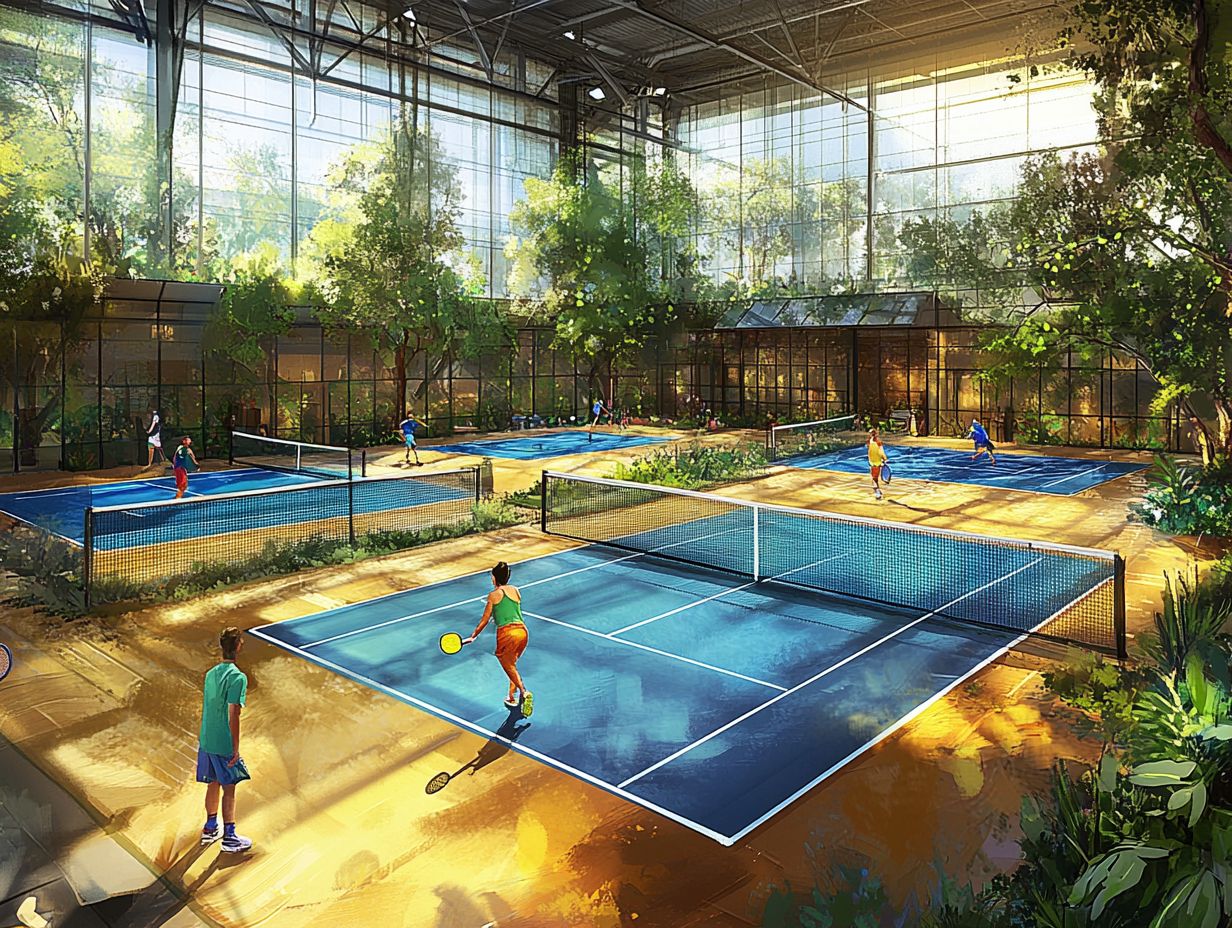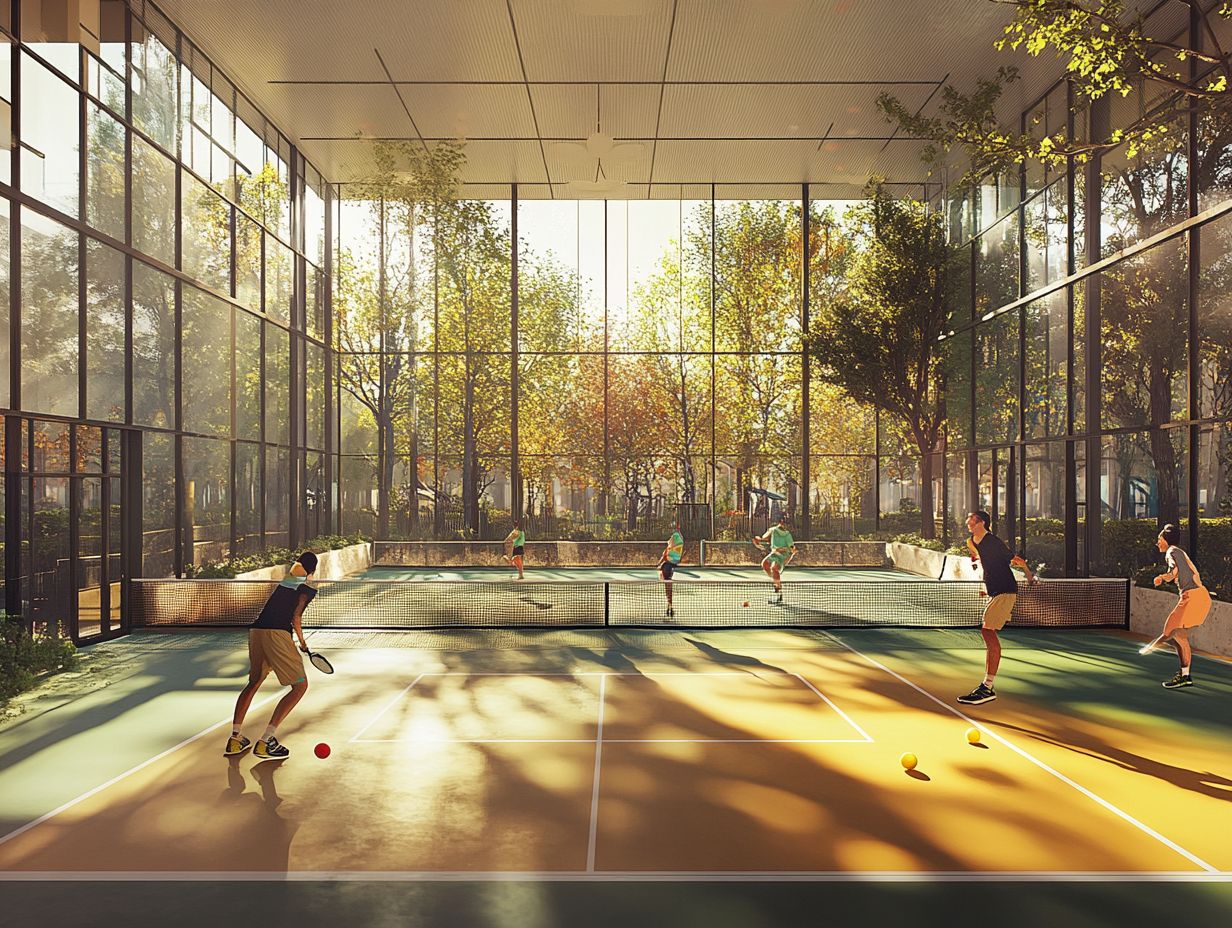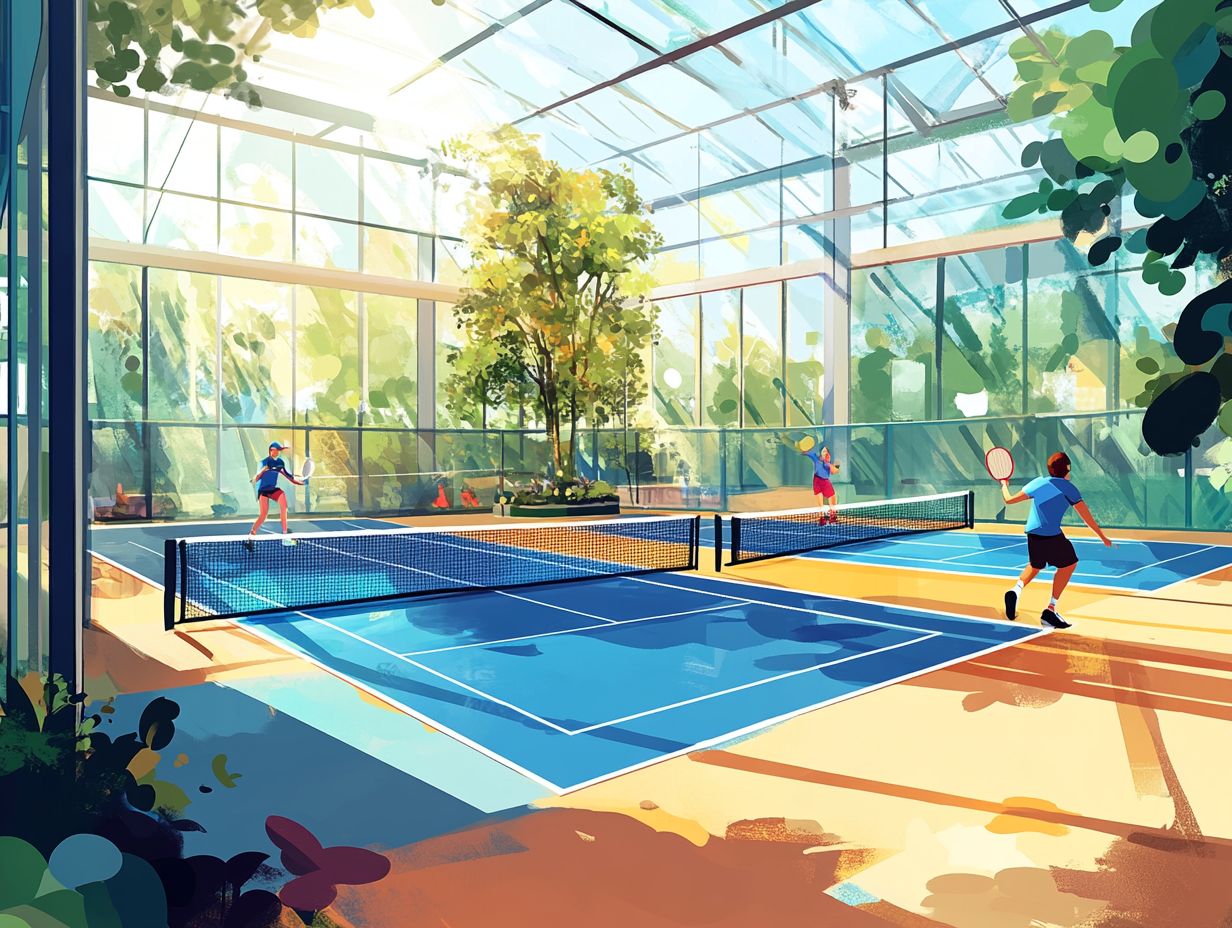Pickleball has rapidly gained popularity in the sports world, enchanting players of all ages with its unique combination of tennis, badminton, and table tennis.
Whether you enjoy the vibrant atmosphere of outdoor courts or the more controlled environment of indoor play, this article provides everything you need to know about the game.
From its history and origins to essential equipment, gameplay rules, and strategies for adapting to different settings, we cover all aspects of pickleball.
Additionally, you’ll discover the many physical and mental health benefits that make this sport an excellent choice for everyone.
History and Origins

The history and origins of pickleball can be traced back to the mid-1960s when it was created as a family-friendly sport that combined elements of tennis, badminton, and ping-pong. The goal was to engage participants of all ages and skill levels while promoting social interaction and community involvement.
As pickleball evolved, it gained popularity across various demographics, leading to the establishment of leagues and tournaments that expanded its reach within recreational sports. Throughout the 1970s and 1980s, significant milestones marked the sport’s growth, including the formation of the United States Pickleball Association in 2005. This organization played a crucial role in standardizing game rules and overseeing competitions.
Community events became essential in fostering participation, with local tournaments and social gatherings providing opportunities for players to connect and share their passion for the game. This emphasis on inclusivity and collaboration has also led to modern adaptations, such as the incorporation of new technologies like online platforms for scheduling and connecting players, further enriching the overall experience.
Indoor Pickleball
Indoor pickleball is played in gymnasiums and indoor facilities equipped with courts that have suitable surfaces, allowing players to enjoy the game year-round regardless of weather conditions.
Although these indoor facilities may also feature outdoor courts, indoor pickleball can be played both recreationally and competitively, utilizing paddles and balls specifically designed for indoor play.
Equipment and Court Setup
When setting up for indoor pickleball, it is essential to use proper equipment, including paddles and balls, as well as court surfaces that meet recommended standards and net height regulations to ensure fair play. Indoor pickleball paddles should be lightweight, ideally made from graphite or composite materials, which minimize air resistance and enhance performance during fast-paced rallies. Unlike their outdoor counterparts, indoor pickleball balls have fewer holes—26 instead of 40—and are designed to be softer, reducing both bounce and noise levels when played indoors.
To set up an indoor pickleball court, begin by measuring a rectangular area that is 20 feet wide and 44 feet long, which corresponds to the dimensions of a standard pickleball court. Next, mark the lines for the service area and the baseline. The net should be hung at a height of 36 inches at the edges and 34 inches at the center. Safety is a priority in this exciting sport; therefore, the playing surface should be clean and provide appropriate traction to minimize slips and injuries.
Rules and Gameplay

Understanding the rules and gameplay mechanics of indoor pickleball is essential for players, as they outline the unique indoor scoring system and highlight the differences in strategies for singles and doubles play. This knowledge fosters both competitive spirit and sportsmanship among players. By mastering the fundamentals of official pickleball rules, players can optimize their performance on the court.
Learning to play indoor pickleball involves familiarizing oneself with regulations that encompass the scoring system—which typically employs rally scoring, meaning teams score points on every serve—equipment specifications, court dimensions, and player conduct. While the scoring system may vary slightly between indoor singles and doubles formats, both methods promote fairness and inclusivity in the game.
A crucial element of indoor pickleball is the non-volley zone, commonly referred to as “the kitchen.” Understanding the rules governing this area can significantly influence the outcome of matches. Moreover, since indoor pickleball is often played cooperatively in doubles, effective communication, strategic planning, and precise shot placement are vital for successful gameplay.
Outdoor Pickleball
Outdoor pickleball provides players with an alternative to indoor play, allowing them to enjoy the game in various weather conditions and on specially designed outdoor court surfaces.
Additionally, it offers opportunities to organize community events that promote participation and social interaction.
Equipment and Court Setup
Proper equipment and court setup are essential for outdoor pickleball. Players should ensure they use the appropriate paddles and balls, while the court surfaces and net height must be configured correctly to optimize gameplay and safety.
The overall experience is enhanced by using lightweight paddles made from composite materials, which provide a good balance of power and control for beginners. In contrast, more advanced players may prefer paddles made from materials like graphite for improved touch and responsiveness.
Choosing high-quality outdoor pickleball balls is equally important, as these are specifically designed to withstand various weather conditions and provide a consistent bounce on rough surfaces.
Outdoor courts should be set up with standard dimensions of 20 feet wide by 44 feet long for doubles play, with the net height set to 36 inches at the ends and 34 inches at the center, ensuring an enjoyable game for all participants.
Rules and Gameplay

The rules and gameplay of outdoor pickleball include a scoring system and regulations for both singles and doubles, providing structure and competitive engagement for players. Understanding these rules can enhance the experience for everyone involved.
In singles play, the rules allow players to showcase their individual skills, as each point won can significantly influence the outcome of the match. In contrast, doubles introduces a different strategy where communication and teamwork are essential for winning points.
Variations in rules, such as different scoring systems (e.g., rally scoring), can shorten match times and elevate the excitement of the game. Adhering to a code of sportsmanship and player etiquette fosters a positive environment, enabling participants of all skill levels to enjoy the game and continue their development.
Adapting Pickleball for Indoor Play
Indoor pickleball is played using a modified version of the sport, which features adjusted training drills and player strategies aimed at enhancing both performance and enjoyment.
Additionally, the game utilizes equipment specifically designed for indoor play.
Tips for Playing Indoors
Indoor play strategies encompass tips for enhancing engagement and performance by focusing on game preparation and player tactics that align with the dynamics of indoor venues. One important aspect is to implement a warm-up routine that includes dynamic stretches and footwork drills.
Additionally, holding brief strategy sessions with teammates before matches can significantly improve coordination. Players should also prioritize their physical fitness on days they are not on the court by incorporating strength training and cardiovascular workouts into their routines.
Staying hydrated and consuming healthy snacks can further help maintain energy levels during play.
Adapting Pickleball for Outdoor Play

Adapting pickleball for outdoor play necessitates careful consideration of various environmental factors and player strategies that enhance both gameplay and safety. This ensures that participants can fully enjoy the sport, regardless of weather conditions.
Tips for Playing Outdoors
To enhance the enjoyment of outdoor pickleball, players can implement various tips that focus on maximizing engagement while considering the unique characteristics of outdoor environments. By adapting to the specific challenges posed by nature, such as sunlight intensity, wind conditions, and potential rain, participants can help ensure that the game remains fun and competitive.
For instance, players can protect themselves from glare by wearing sunglasses or hats, and they can use brightly colored balls to improve visibility in different lighting conditions. Staying properly hydrated is essential on hot days, as outdoor play can lead to fatigue.
Additionally, during community events, organizing tournaments with flexible game schedules that allow for breaks as needed can encourage greater participation and enthusiasm among players, regardless of the weather conditions.
Benefits of Playing Pickleball
Playing pickleball offers numerous benefits, including improved physical fitness, better mental health, increased social interactions, and enhanced community engagement.
This makes it an excellent sport for individuals of all ages, skill levels, and adaptive sports participants.
Physical and Mental Health Benefits
Pickleball offers numerous physical and mental health benefits by promoting a healthy lifestyle through regular physical activity and providing opportunities for social interaction and stress relief.
The running and movement required during the game enhance cardiovascular fitness, benefiting heart health and building stamina. Additionally, the rapid movements and necessary positioning on the court improve players’ hand-eye coordination, agility, and reflexes.
Participating in pickleball also provides mental advantages by releasing endorphins, which help alleviate stress and anxiety. Furthermore, the community and connections formed with fellow players foster a sense of belonging that supports mental well-being and cultivates friendships, ultimately enhancing overall quality of life.

Pickleball’s more than a game to me—it’s a passion. I write, sharing its highs and lows, the thrills and the lessons. Some tales might draw you to the court, while others give a hint of the game’s magic. So, curious about my journey? Ready to dive deep into the world of pickleball with me? Let’s go.
